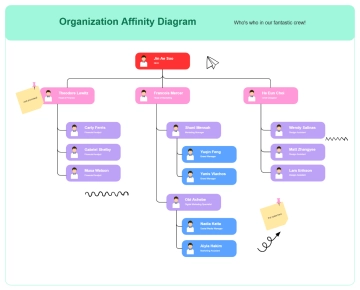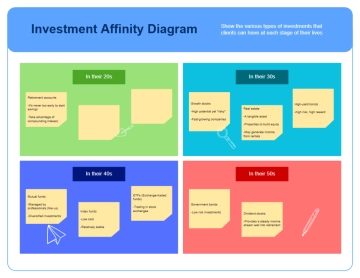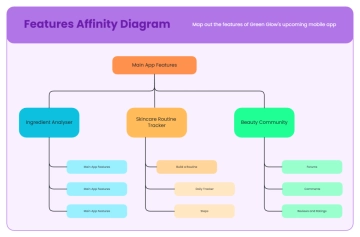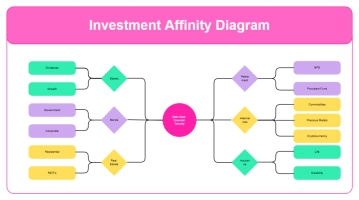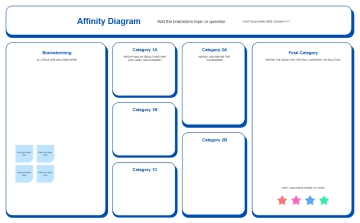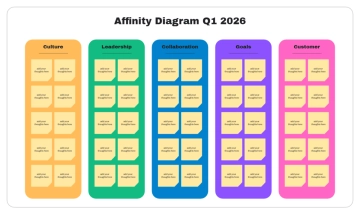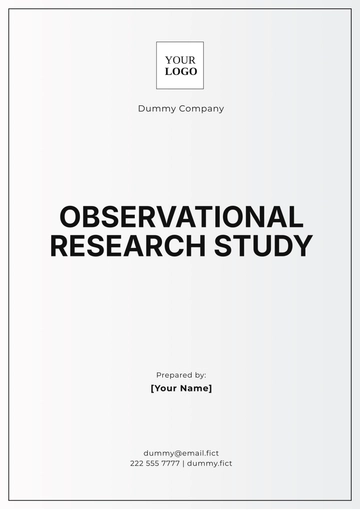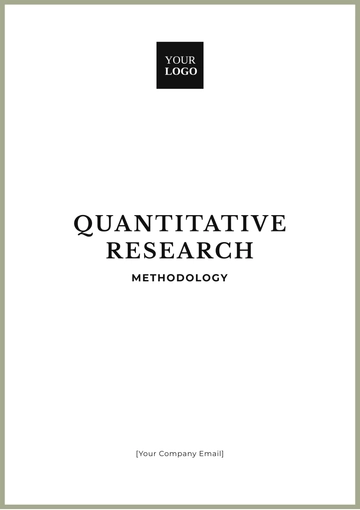Free Extensive Financial Investment Research
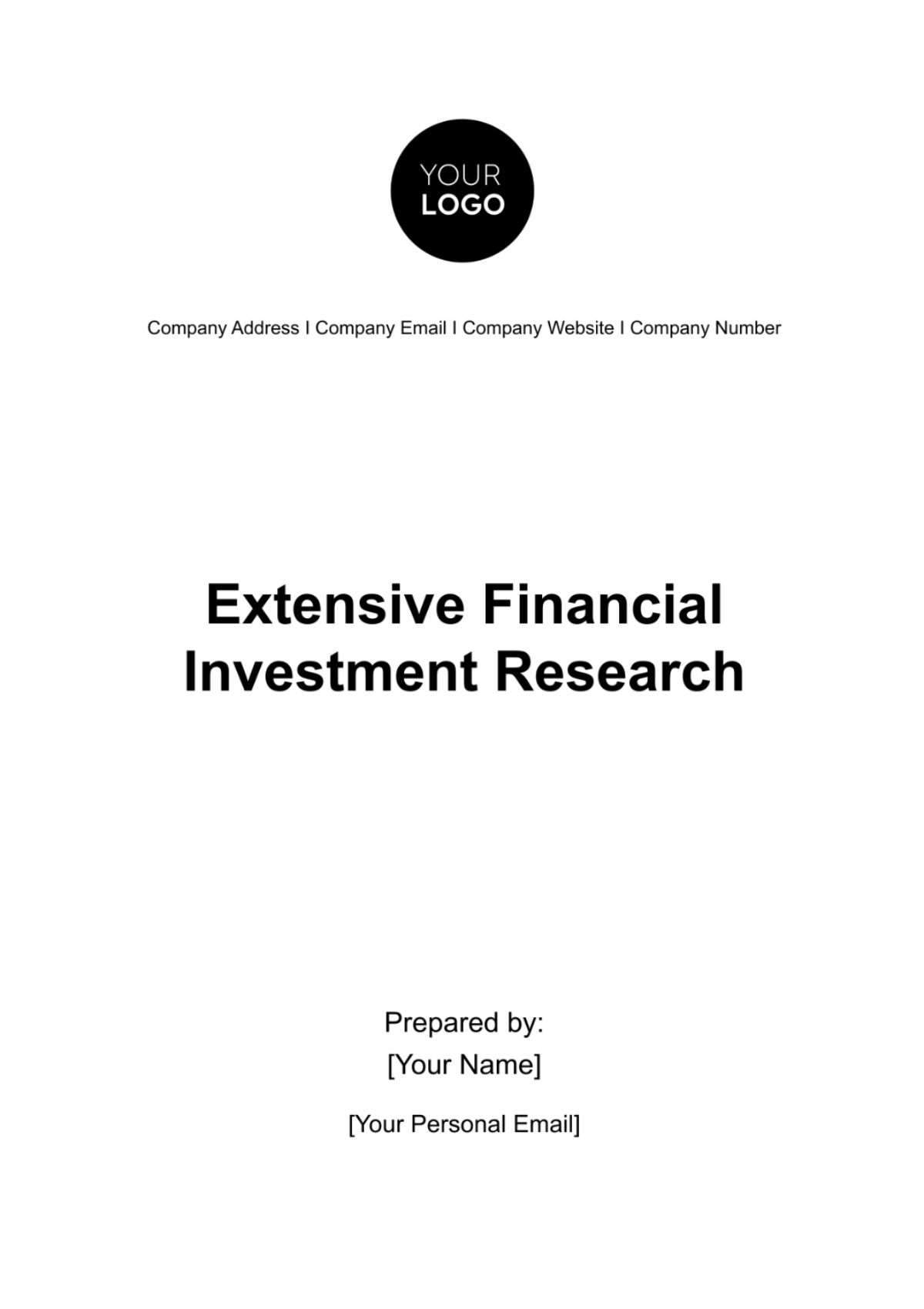
Introduction
In this comprehensive financial investment research document, we provide an in-depth analysis of a promising investment opportunity that aligns with current market trends and future growth prospects. Our focus is on a diversified investment strategy that encompasses a range of asset classes, including equities, bonds, and alternative investments, with a particular emphasis on emerging technologies and sustainable energy sectors. This approach is designed to capitalize on both short-term market movements and long-term economic shifts, balancing potential risks with the opportunity for significant returns.
Key Findings
Market Resilience and Growth Potential: Our research indicates that despite recent market volatility, there are significant growth opportunities, particularly in sectors driven by technological innovation and sustainability. These sectors have demonstrated resilience and are projected to experience substantial growth over the next decade.
Diversification as a Risk Management Tool: We found that a diversified portfolio, spread across various asset classes and geographic regions, significantly reduces risk while maintaining the potential for high returns. This strategy is especially pertinent in the current global economic climate, characterized by uncertainty and rapid change.
Increasing Relevance of ESG Factors: Environmental, Social, and Governance (ESG) considerations are becoming increasingly important for investors. Our analysis shows that investments in companies with strong ESG practices not only contribute to a more sustainable and ethical business environment but also tend to yield better long-term financial performance.
Technological Advancements Shaping Investment Landscapes: The rapid advancement in technologies such as artificial intelligence, renewable energy, and biotechnology is creating new investment frontiers. Companies leading in these areas are well-positioned for growth, and investing in these sectors offers the potential for substantial returns.
Recommendations
Invest in Growth-Oriented Sectors
Prioritize Diversification
Incorporate ESG Factors into Investment Decisions
Stay Abreast of Technological Developments
Market Analysis
In this section, we delve into a comprehensive analysis of the current global and regional economic environments, identifying key trends and drivers shaping the investment landscape. Our focus is on understanding the dynamics of various industries and evaluating the competitive landscape to inform our investment strategies.
Global and Regional Economic Outlook
The global economy is currently experiencing a period of transformation, influenced by several macroeconomic factors. These include fluctuating interest rates, varying growth rates across regions, and evolving trade relations. Regionally, we observe divergent economic performances, with emerging markets showing robust growth potential, while developed markets face challenges due to political uncertainties and demographic shifts.
Market Trends and Drivers
Trend/Driver | Description | Impact on Market |
Technological Advancements | Rapid innovation in areas such as AI, IoT, and renewable energy. | Positive; driving growth in tech and energy sectors. |
Shift Towards Sustainability | Increasing focus on sustainable practices and green technologies. | Positive; boosting demand in sustainable industries. |
Geopolitical Tensions | Ongoing trade disputes and political instability in certain regions. | Mixed; leading to market volatility but also opportunities in defense and cybersecurity. |
Demographic Changes | Aging populations in developed nations vs. younger demographics in emerging markets. | Varied; impacting consumer markets and healthcare sectors differently. |
Monetary Policy Adjustments | Central banks' responses to global economic conditions through interest rate changes. | Significant; influencing investment in bonds and interest-sensitive sectors. |
Industry Analysis and Competitive Landscape
Industry | Leading Competitors | Share (%) | Notes |
Technology | TechCorp, Innovate Inc., FutureTech | 20, 15, 10 | High growth, driven by innovation and consumer demand. |
Renewable Energy | GreenEnergy, EcoPower, SolarWave | 25, 20, 15 | Growing sector with increasing government support. |
Pharmaceutical | PharmaGlobal, HealthSolutions, Medico | 30, 25, 20 | Steady growth, influenced by aging populations and R&D. |
Consumer Goods | GoodLife, EverydayProducts, People's Choice | 18, 16, 14 | Competitive, impacted by demographic and lifestyle changes. |
Financial Services | MoneyWise, SecureInvest, WealthGrow | 22, 20, 18 | Dynamic, shaped by economic policies and tech integration. |
Investment Thesis
In this section, we articulate the foundational principles and strategic rationale behind our investment decisions, outlining both our short-term and long-term objectives. We aim to provide a clear and coherent investment thesis that balances the anticipated risks with the potential returns.
Rationale Behind the Investment
Our investment approach is guided by the principle of achieving sustainable and robust returns through a blend of tactical asset allocation and strategic market positioning. We recognize the importance of adapting to evolving market conditions while maintaining a steadfast focus on sectors and assets that demonstrate strong potential for growth and resilience. This strategy is underpinned by a deep analysis of market trends, technological advancements, and socio-economic shifts that are likely to shape the investment landscape in the coming years.
Short-term Objectives
Generate competitive returns above market average within a 1-3 year timeframe.
Capitalize on immediate market opportunities presented by short-term economic fluctuations and sector-specific developments.
Maintain liquidity and flexibility to respond to rapid market changes and unforeseen events.
Long-term Objectives
Achieve substantial capital appreciation over a horizon of 5-10 years.
Foster portfolio growth through investments in sectors with long-term growth trajectories, such as technology and renewable energy.
Contribute to sustainable and socially responsible investing, aligning with global ESG trends and standards.
Risk and Return Analysis
Our risk and return analysis framework is designed to balance the pursuit of high returns with the management of associated risks. This involves:
Utilizing financial models to predict potential returns and assess the volatility of various asset classes.
Considering non-financial factors, such as regulatory changes, market sentiment, and geopolitical events, which could impact investment performance.
Spreading investments across different asset classes and geographies to reduce exposure to any single risk factor.
Asset Analysis
In this section, we conduct a thorough analysis of various asset classes including stocks, bonds, and real estate, examining their historical performances and projecting future trends. This analysis is critical in shaping our investment strategy, allowing us to make informed decisions based on past trends and future forecasts.
Overview of the Asset Class
Stocks: Represent ownership in companies and offer the potential for high returns, but with higher risk and volatility. They are a key component in most investment portfolios due to their growth potential.
Bonds: Provide a fixed income and are generally considered lower risk compared to stocks. They are crucial for portfolio diversification and stability, especially in uncertain market conditions.
Real Estate: Tangible assets that offer unique advantages such as potential rental income and appreciation. Real estate investments can be a hedge against inflation and provide portfolio diversification.
Historical Performance Analysis
Future Projections and Forecasts
Stocks: Expected to continue experiencing volatility in the short term due to economic uncertainties. Long-term growth prospects remain positive, particularly in technology and healthcare sectors.
Bonds: Likely to see moderate returns, influenced by interest rate movements and economic policies. Government and high-quality corporate bonds are expected to remain stable investment choices.
Real Estate: Projected to see steady growth, especially in urban and developing areas. Commercial real estate could face challenges, while residential real estate is expected to flourish due to demographic shifts.
Financial Analysis
In this section, we delve into a meticulous examination of financial statements, conducting an in-depth ratio analysis and evaluating cash flow projections. This rigorous financial analysis forms the backbone of our investment decision-making process, enabling us to assess the financial health and future prospects of potential investments.
Income Statement
Item | Amount (in millions) | Notes |
Total Revenue | $500 | High year-over-year growth. |
Cost of Goods Sold (COGS) | $200 | Stable as a percentage of revenue. |
Gross Profit | $300 | Good margin maintenance. |
Operating Expenses | $100 | Includes R&D, SG&A. |
Operating Income | $200 | Healthy operating margin. |
Interest Expense | $20 | Consistent with prior years. |
Net Income | $150 | Solid bottom line, post-tax. |
Balance Sheet
Item | Amount (in millions) | Notes |
Total Assets | $1,000 | Significant growth in assets. |
Total Liabilities | $400 | Includes long-term debt. |
Total Equity | $600 | Strong equity position. |
Current Assets | $300 | Adequate liquidity. |
Current Liabilities | $150 | Current Ratio > 1, good liquidity. |
Ratio Analysis
Ratio Type | Result | Industry Avg. | Notes |
Gross Profit Margin | 60% | 55% | Above industry average, efficient management. |
Operating Margin | 40% | 35% | Strong profitability from operations. |
Net Profit Margin | 30% | 25% | Healthy bottom-line profitability. |
Current Ratio | 2 | 1.5 | Good short-term financial health. |
Debt-to-Equity Ratio | 0.67 | 0.8 | Lower than average, less reliance on debt. |
Return on Equity (ROE) | 25% | 20% | Strong return on equity investment. |
Cash Flow Analysis and Projections
Risk Assessment
In this crucial section, we evaluate the various risks associated with our investment portfolio, ranging from market to operational risks. Understanding and managing these risks is essential to ensure the stability and success of our investment strategy.
Potential Risks | Risk Mitigation Strategies |
Market Risk | Diversification across asset classes and sectors; use of hedging instruments. |
Credit Risk | Rigorous credit analysis; investment in high credit quality assets. |
Liquidity Risk | Maintaining a balance of liquid assets; regular monitoring of market conditions. |
Operational Risk | Implementing robust internal controls and risk management systems. |
Interest Rate Risk | Duration management in bond investments; use of fixed-to-floating interest rate swaps. |
Geopolitical Risk | Geographic diversification; staying informed about global political developments. |
Regulatory Risk | Compliance with regulatory changes; proactive legal and compliance reviews. |
Currency Exchange Risk | Use of currency hedging strategies; investing in currency-neutral instruments. |
Inflation Risk | Investing in inflation-protected securities; focus on real assets. |
Technology Risk | Investing in technology to enhance operational efficiency; cybersecurity measures. |
Stress Testing and Scenario Analysis
In addition to identifying and mitigating various investment risks, we also conduct stress testing and scenario analysis. These methods allow us to evaluate how our portfolio would perform under extreme but plausible adverse conditions. Below is a table that details some of the stress tests and scenarios we consider:
Scenario Type | Description | Potential Impact on Portfolio |
Economic Downturn | A significant decline in global economic activity, such as a recession. | Assess portfolio resilience during economic slumps, focusing on asset classes most affected. |
Market Crash | A rapid and substantial decline in the stock market. | Evaluate the impact on equity investments and potential ripple effects on other asset classes. |
Interest Rate Spike | A sudden and significant increase in interest rates. | Determine the effect on bond prices and interest-sensitive stocks. |
Geopolitical Crisis | Escalation of international conflicts or trade wars. | Analyze the impact on global investments and sectors sensitive to geopolitical tensions. |
Technology Disruption | Major technological failures or cybersecurity incidents. | Understand the vulnerability of tech investments and operational risks. |
Regulatory Changes | Introduction of significant regulatory reforms in key markets. | Evaluate how changes in regulations could impact various sectors and investment strategies. |
Natural Disasters | Occurrence of significant natural events like earthquakes or hurricanes. | Assess the effect on insurance, real estate, and other disaster-sensitive investments. |
Regulatory and Compliance Overview
In this section, we outline our approach to navigating the complex landscape of financial regulations and compliance requirements. Staying abreast of and adhering to relevant laws and regulations is fundamental to our operational integrity and investment success.
Relevant Laws and Regulations
Our investment activities are governed by a comprehensive set of laws and regulations, which vary by region and asset class. Key regulatory frameworks include:
Securities and Exchange Regulations: Governing the trading of stocks, bonds, and other securities, these regulations ensure fair and transparent market practices.
Banking and Financial Services Laws: These laws regulate the operations of financial institutions and include provisions for capital requirements, risk management, and consumer protection.
Tax Laws: Tax regulations impact investment structures and returns. We stay updated on both domestic and international tax laws relevant to our investments.
Environmental, Social, and Governance (ESG) Regulations: With the growing focus on sustainability, ESG regulations are increasingly relevant, especially for investments in industries like energy, manufacturing, and technology.
Compliance Requirements
Our compliance strategy includes:
Regular Audits and Reviews: Conducting periodic audits to ensure adherence to financial reporting standards and regulatory requirements.
Compliance Training Programs: Regular training for our staff to stay informed about the latest regulatory developments and ethical investment practices.
Internal Controls and Reporting Mechanisms: Establishing robust internal controls and reporting systems to prevent and detect violations of laws and regulations.
Impact of Regulatory Changes
Regulatory changes can significantly impact investment strategies and returns. For instance, changes in interest rate policies by central banks can affect the valuation of bonds and equities. Similarly, new environmental regulations can alter the investment landscape for industries such as energy and manufacturing. We continuously monitor regulatory developments, assessing their potential impact on our investments and adjusting our strategies accordingly to mitigate risks and capitalize on new opportunities.
ESG Factors
This section is dedicated to analyzing the impact of Environmental, Social, and Governance (ESG) factors on our investment decisions, a crucial aspect in today's globally conscious market. We recognize the growing importance of ESG considerations in sustainable investment practices and corporate responsibility.
Analysis of ESG Impact and Sustainability
Our approach to ESG analysis involves:
Environmental Impact: Assessing potential investments for their environmental footprint, including resource utilization, waste management, and carbon emissions. We prioritize companies that demonstrate a commitment to reducing their environmental impact and investing in sustainable practices.
Social Responsibility: Evaluating companies based on their social impact, including labor practices, community engagement, and consumer protection. We focus on investments in companies that exhibit strong social responsibility and contribute positively to society.
Governance Practices: Analyzing the governance structure of companies, including board composition, executive compensation, and shareholder rights. Strong governance practices are crucial for ensuring accountability and aligning the interests of management with those of shareholders.
Corporate Governance Review
In our review of corporate governance, we look for:
Transparent and ethical leadership practices.
Effective risk management and internal controls.
Fair and responsible executive compensation.
Active and independent board oversight.
Social and Environmental Responsibility
Our commitment to social and environmental responsibility involves:
Investing in companies that have a positive impact on their communities and the environment.
Avoiding investments in industries that negatively affect social welfare or the environment, such as tobacco or fossil fuels.
Engaging with companies to encourage improved ESG practices, where applicable.
Portfolio Construction and Allocation
In this section, we outline our approach to constructing and allocating the investment portfolio, emphasizing the strategic importance of asset allocation, diversification, and rebalancing. Our aim is to build a robust portfolio that aligns with our investment objectives while effectively managing risk.
Asset Allocation Strategies
Asset allocation is the cornerstone of our investment approach. Our strategies include:
Strategic Asset Allocation: Setting target allocations for various asset classes based on their expected risk and return characteristics, aligning with our long-term investment objectives.
Tactical Asset Allocation: Making short-term adjustments to our portfolio composition in response to changing market conditions or opportunities.
Alternative Investments: Including non-traditional assets like private equity, hedge funds, and real assets to diversify the portfolio and enhance potential returns.
Diversification Tactics
Diversification is key to managing risk and enhancing returns. Our tactics include:
Across Asset Classes: Investing in a mix of stocks, bonds, and alternative assets to spread risk.
Geographic Diversification: Allocating investments across various global markets to mitigate the impact of regional economic fluctuations.
Sector Diversification: Spreading investments across different industries and sectors to reduce sector-specific risks.
Portfolio Rebalancing Guidelines
Portfolio rebalancing is essential to maintain the desired risk level and asset allocation over time. Our rebalancing approach involves:
Regular Review and Rebalancing: Periodically reviewing the portfolio to realign it with our target asset allocation, typically on a quarterly or annual basis.
Threshold-Based Rebalancing: Implementing rebalancing when an asset class’s weight deviates significantly from its target, ensuring the portfolio remains aligned with our risk tolerance and investment goals.
Market Condition Adjustments: Taking advantage of market conditions to rebalance the portfolio in a cost-effective manner, such as using market dips to buy undervalued assets.
Investment Management and Oversight
This section focuses on our robust approach to investment management and oversight, highlighting the key roles and structures in place to ensure the highest standards of governance and decision-making. Effective management and oversight are fundamental to our success, guiding our investment processes and ensuring accountability and transparency.
Management Team and Governance Structure
Role | Responsibilities | Key Qualifications |
Chief Investment Officer | Oversees the investment strategy and risk management. | Extensive experience in investment management, strong track record. |
Portfolio Managers | Develop and execute investment strategies for specific asset classes. | Expertise in their respective asset classes, analytical skills. |
Risk Management Officer | Monitors and manages investment risks. | Expertise in risk analysis and management. |
Compliance Officer | Ensures adherence to regulatory requirements and ethical standards. | Knowledge of laws and regulations, integrity. |
Research Analysts | Provides in-depth market analysis and investment insights. | Strong analytical skills, sector-specific knowledge. |
Investment Process and Decision-Making Framework
Our investment process is grounded in a structured and systematic approach:
Market Research and Analysis: Continuous monitoring of market trends, economic indicators, and geopolitical developments.
Asset Selection: Utilizing both quantitative and qualitative methods to select assets that align with our investment criteria and objectives.
Risk Assessment: Evaluating potential risks at both the asset and portfolio levels.
Decision-Making: Decisions are made through a collaborative approach, combining insights from our analysts, portfolio managers, and the risk management team.
Monitoring and Performance Evaluation
Aspect | Frequency | Metrics Used | Objective |
Portfolio Performance | Quarterly | ROI, Alpha, Sharpe Ratio | Assessing performance against benchmarks and goals. |
Risk Profile Assessment | Bi-annually | Value at Risk (VaR), Stress Tests | Monitoring risk levels and exposures. |
Compliance Checks | Annually | Regulatory adherence, Audit outcomes | Ensuring compliance with laws and standards. |
Market Alignment Review | Annually | Market trends, Portfolio positioning | Aligning portfolio with market changes. |
Tax Implications
In this section, we address the vital role that tax considerations play in our investment strategy and decision-making process. Understanding and managing the tax implications of our investments is crucial for optimizing returns and adhering to legal and regulatory standards.
Tax Impact on Investment Returns
Taxes can significantly affect investment returns, and our approach includes:
Capital Gains Tax: Monitoring the holding periods of investments to potentially benefit from lower long-term capital gains tax rates.
Dividend Taxation: Understanding the tax treatment of different types of dividends (qualified vs. non-qualified) to optimize after-tax returns.
Interest Income Tax: Assessing the impact of taxes on interest income from bonds and other fixed-income investments.
Tax-Efficient Investment Strategies
We employ several strategies to enhance tax efficiency:
Tax-Loss Harvesting: Offsetting capital gains with losses to reduce tax liability.
Asset Location: Placing assets in the most tax-efficient accounts (e.g., placing high-growth investments in tax-deferred accounts).
Municipal Bonds: Investing in municipal bonds for tax-exempt interest income, particularly beneficial for investors in higher tax brackets.
International Tax Considerations
For international investments, our considerations include:
Withholding Taxes on Foreign Investments: Understanding the tax withheld at the source on foreign investment income and the possibility of tax credits or deductions.
Double Taxation Agreements: Leveraging treaties between countries to avoid double taxation on the same income.
Repatriation of Income: Assessing the tax implications and strategies for repatriating income from international investments back to the investor's home country.
Conclusion
Throughout this extensive financial investment research document, we have delved into various critical aspects of investment strategy, from market analysis to risk assessment and tax considerations. Our comprehensive approach, grounded in detailed analysis and strategic planning, aims to guide our investment decisions towards sustainable profitability and growth.
Key Takeaways
Strategic Market Positioning: By thoroughly understanding market dynamics and trends, we are positioned to capitalize on opportunities and mitigate potential risks.
Diversified Investment Approach: Our focus on diversification across asset classes, regions, and industries is crucial in balancing risks and optimizing returns.
Robust Risk Management: Our commitment to rigorous risk assessment and mitigation strategies ensures the resilience of our portfolio under various market conditions.
Adherence to Regulatory Standards: Our proactive approach to compliance and governance safeguards our operations and aligns with legal and ethical standards.
ESG Integration: Embracing Environmental, Social, and Governance factors reflects our commitment to responsible investing and aligns with global sustainability trends.
Tax Efficiency: By considering the tax implications of our investment choices, we enhance the after-tax returns for our stakeholders.
In conclusion, our investment philosophy is built on a foundation of research, analysis, and strategic foresight. We believe that this approach, combined with our commitment to excellence and integrity, positions us well to achieve our investment objectives and deliver long-term value to our stakeholders. As we move forward, we remain dedicated to adapting our strategies in response to evolving market conditions, emerging trends, and the changing needs of our investors.
- 100% Customizable, free editor
- Access 1 Million+ Templates, photo’s & graphics
- Download or share as a template
- Click and replace photos, graphics, text, backgrounds
- Resize, crop, AI write & more
- Access advanced editor
Extensive Financial Investment Research Template from Template.net is a comprehensive tool for investors and analysts. Fully editable and customizable in our AI Editor tool, this document streamlines complex financial analysis, offering clear, structured formats for deep investment research. Its user-friendly design allows for seamless adaptation to specific needs, making it an indispensable asset for thorough financial assessments.



